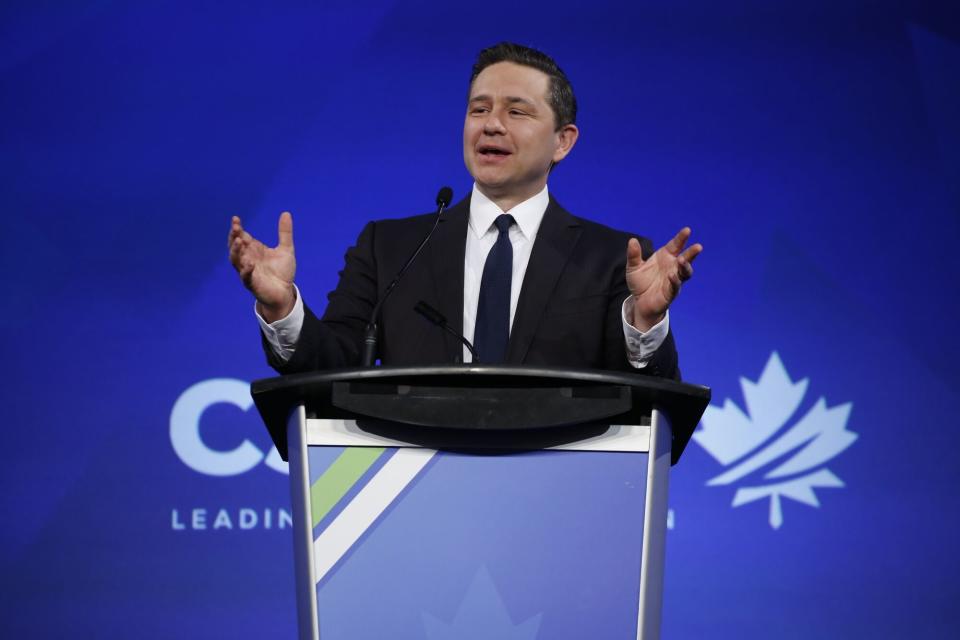Bank of Canada to Explain Its Pandemic Actions as Political Tides Shift
(Bloomberg) -- The Bank of Canada is doing a formal review of its pandemic-era policies, when it bought hundreds of billions in government bonds to suppress interest rates. It may represent a last chance for Governor Tiff Macklem to explain himself before one of his fiercest critics comes to power.
Most Read from Bloomberg
Nvidia’s 13% Stock Rout Has Traders Scouring Charts for Support
BuzzFeed Struggles to Sell Owner of Hit YouTube Show ‘Hot Ones’
Jain Global Raises $5.3 Billion, Secures Cash From Abu Dhabi
How Long Can High Rates Last? Bond Markets Say Maybe Forever
Wikileaks’ Julian Assange to Plead Guilty, Ending Yearslong US Battle
Early next year, the central bank plans to release a report on the “exceptional” measures it took during the Covid shock. That’s likely to be shortly before Canada’s next election, which is due to take place by October 2025.
Conservative Party Leader Pierre Poilievre — who’s leading Prime Minister Justin Trudeau by a hefty margin in polls — slammed the central bank during its first-ever foray into quantitative easing, saying it contributed to inflation. During his campaign for the party leadership in 2022, he even threatened to fire Macklem if elected.
Should Poilievre win next year, that would put him in the country’s highest office ahead of a scheduled review of the bank’s mandate in 2026 and the end of Macklem’s term in 2027. As the bank renews its framework, a Conservative government would likely want to scrutinize tools such as quantitative easing.
But first, the bank will conduct its own review — which will include an external assessment by central banking experts — to deliver a verdict on what role the bond-buying and other actions played in the run-up in inflation, which peaked at 8.1% in June 2022.
In a speech on June 13, Deputy Governor Sharon Kozicki cited bank research that showed quantitative easing added as much as 3% to the country’s gross domestic product at its peak. She didn’t mention another finding of the report — the emergency bond purchases added 1.8 percentage points to inflation.
The bank’s position is that supply disruptions and higher commodity prices were the primary contributors to inflation, and Kozicki said policymakers see “very little correlation” between the increase in the country’s money supply and the inflation surge.
The bank said quantitative easing was initially deployed to restore market functioning during the economic shock of the pandemic. It complemented then-Governor Stephen Poloz’s decision to cut interest rates from 1.75% to 0.25%, injected liquidity throughout financial markets and helped to keep longer term borrowing costs lower.
Still, monetary policymakers under Macklem continued large asset purchases well into the recovery. In total, the bank bought C$340 billion ($248 billion) in bonds, and at peak in 2021 the central bank held as much as 43% of Canadian government bonds on its balance sheet.
That allowed Trudeau’s government to issue record amounts of debt at lower costs than it otherwise would have faced, helping pay for wage subsidies and other programs to keep the economy afloat in 2020.
“How much of that fiscal was aided by the bank being ready to buy those bonds during QE? That, I think, is a legitimate question,” said Jeremy Kronick, associate vice president of the C.D. Howe Institute.
While the Bank of Canada wasn’t buying most of its bonds directly from the primary government auctions, its purchases in secondary markets may have given other market players the confidence to buy from the government at higher prices than they would have otherwise paid, Kronick said.
In 2020, when Poilievre was the Conservative finance critic, he accused the Bank of Canada of acting as “an ATM for Trudeau’s insatiable spending appetites.” During his successful bid to win his party’s leadership in 2022, Poilievre told supporters he planned to sack Macklem — a pledge that drew considerable criticism from economists and which he hasn’t repeated lately.
The bank’s review of its pandemic response has the potential to “calm down” its relationship with Conservatives, said Yaroslav Baran, a former communications strategist for Prime Minister Stephen Harper’s Tory government who now works at consulting firm Pendulum Group.
“It sets the Bank of Canada up for a reputational rehabilitation in quarters where they were criticized,” Baran said. An acknowledgment that the size, intensity and duration of quantitative easing led to at least some additional inflationary pressures would be “well-received,” he said.
With yearly inflation headed toward the central bank’s 2% target, it will probably be easier by next year for the central bank to make the case that its emergency measures were ultimately successful.
Bank of Canada spokesman Paul Badertscher said officials will unveil details in coming weeks, including a list of central banking and academic experts who will evaluate the bank’s findings.
Asked to comment on the bank’s upcoming review, Poilievre’s media relations team pointed to a short documentary called “Housing Hell” released last year. In it, the Conservative leader repeats statements that government spending, quantitative easing and the expansion of the money supply were major contributors to housing inflation.
“There’s really not a good way to directly pinpoint what the effect of QE on inflation would be, in isolation,” Citigroup economist Veronica Clark said in an interview. “While it was probably both loose fiscal and monetary, a lot of the inflation is easier to pinpoint directly more to the fiscal side of things.”
Most Read from Bloomberg Businessweek
How Jeff Yass Became One of the Most Influential Billionaires in the 2024 Election
Why BYD’s Wang Chuanfu Could Be China’s Version of Henry Ford
Independence Without Accountability: The Fed’s Great Inflation Fail
©2024 Bloomberg L.P.

 Yahoo News
Yahoo News 



